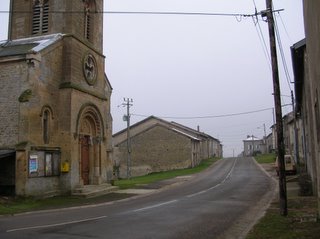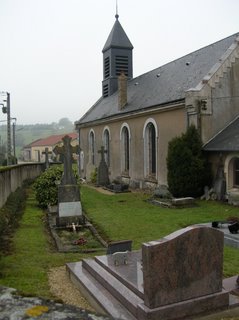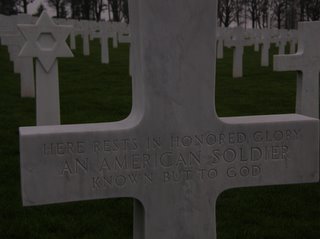I had a few days to do some exploring, so I thought I'd check out some of the places Grandpa stayed when he was here. So, here is the story of what I found.
Drove east out of Paris for 2 hours on A4, then exit and continue on, mostly further east and a little north. At every intersection, take the smaller of the two roads, until finally all of the roads are barely one-and-half cars wide, just ambling through the French country side. All small towns. To an American driving through on a cold December morning, they all look the same. Agricultural countryside, crops long since harvested for the year, winter rye showing through the frost. Towns spaced about every 10 km. Rolling hills, reminiscient of western Kentucky, without the split rail fences, and without the roadside advertising.

All the towns have really only four identifiable features, and three of them are the same for each town.
The black lettering on the white sign to tell you where you are on the map; about 10 or 15 old grey buildings, older than memory, serving as either houses, cow barns, or maybe a local general store;

a church in the center of the town, the tallest structure;
and next to the church, a memorial to the local men who served, and mostly died, between 1914-18.

Rolled through a slightly larger town, Varennes-en-Argonne. Looked strangely familiar. I think, perhaps, Grandpa was here. Can you check his stack of photographs?
This is what it looks like today:

I seem to remember a similar photograph or two, black & white, with soldiers about, of the church, and the mill on the hill across the river.

Went into the hotel to use the restroom. Three old men sitting in the bar, one with a cigarette, one with a beer, one with a glass of red wine. It's 10:00 AM on a cold December morning. The one with the full head of grey hair, the beer drinker, telling a story, the other two acting like they had not heard before. The interior of the old building is spotlessly clean.

Drive on, visiblity low, temperature steady at 1 deg C. Fog hangs heavy, like the history in this area.
Grandpa's DSC citation says he was in action near Mamey and Cuisy.
OK, so on to Mamey first.
To an American on a cold December day, 3 days before Christmas, nothing special about this town is obvious. One old man walking up his mud drive carrying a bucket, perhaps some feed for the chickens.

No place to stop for a coffee, no other activity about.
No reason to think this should be a decisive location in the history of the war, but I guess battles don't care what came after, or before, for that matter.
Drive on towards Cuisy.
Another hill, another town.

Down in the valley, a small cluster of buildings, captive between two facing hillsides. Must be Cuisy in the valley below. One can imagine countless trenches and artillery lined up on opposite sides of the valley, facing each other, waiting for the first to flinch to decide the moment, the day, perhaps the rest of the war.

Turn right, drive down the dirt road.
Cuisy.

Same small town, same church, same memorial. One of hundreds of similar French towns in this part of the country. This one is unique to me, only because Grandpa survived long enough again this day to gain the other hillside. No place to stop for a coffee, no activity about on a cold Thursday afternoon, 3 days before Christmas. One house has a few red and gold decorations hanging outside a window facing the main street.

One backyard has a small American flag next to the barn. Noone about to ask about this; it will stay a mystery.
Decide to walk about, over the next hill. Ground nearly frozen this time of the year. Better than September and October when Grandpa was here. I imagine it was just as cold then, but everything turned to mud from the rains and the constant footsteps and heavy vehicles. Through the fog, crest the next hill, an abandoned structure. Bombed out church. Taken by the Germans on Sep 11, 1914, re-taken by the French and US forces in September 1918. In the intervening years, the town and the church destroyed.

This town different than the others in the area; this one not to be re-built.
Keep moving, further north and a little westward. Next hill. Through the fog, smooth white surfaces. All day, everything has been stone and earth. Shiny white marble looks stangely out of place, yet calm, not disturbing. The boundary between the marble and the fog is elusive. Look again. 14,246 pieces of marble, each one marking the grave of an American who didn't leave France.

The markers have names, dates, divisions, home states marked on them. All of the states, all manner of family names.
Choice of marker: Latin cross or Star of David.
Choice of date: September, 1918 or October, 1918.

Up the next hill, introduced myself to the supervisor of the memorial. Middle aged guy, American accent, ball cap with American flag on the front. Told him my grandfather earned the DSC in this area; he expressed great interest in knowing more when I told him Grandpa was a balloonist.
This is what he told me: "You know, there was only one American balloonist killed in the war. Amazing when you consider how dangerous it was. He is buried here, out in that field. Perhaps your grandfather knew him".

And then he said this: "You know, there was one balloonist who used up three balloons in the same day, and survived."
This is what I said: "Yeah, that was my grandfather." He read the copy of the DSC citation I had with me.
Then he said: "Can I have a copy of this?" And: "Do you have a photograph of him that I can have? We are putting together a display that we share with visiting dignitaries, about the history of the Americans who served in this area." So I told him I would gather up some photos and send them to him.
Then he said: "You know, you oughta come back the last Sunday in May. We do a real nice memorial ceremony here with both American and French troops. I think your grandfather would appreciate it. The fog should lift by then."
